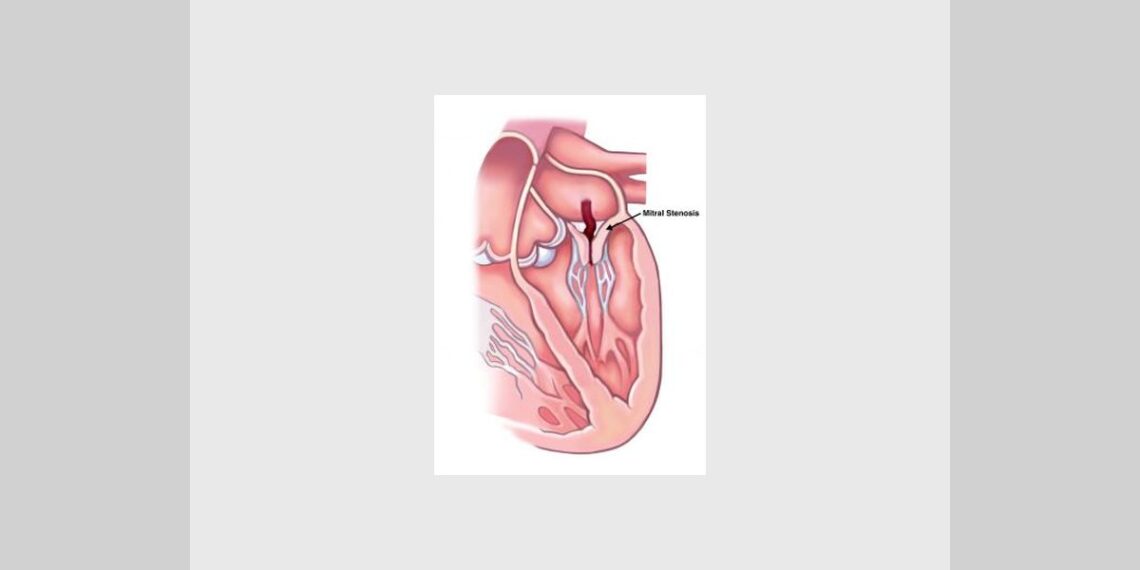Mitral stenosis describes narrowing and calcification of the mitral valve, resulting in obstructed blood flow from the left atrium to the left ventricle. The continued resistance to blood flow results in left atrial enlargement, and further backup of this flow results in pulmonary hypertension and right ventricular hypertrophy, rheumatic fever causes almost all cases of mitral stenosis.
Pathophysiology of mitral stenosis
Mitral stenosis characterized by mechanical obstruction to left ventricular diastolic filling secondary to a progressive decrease in mitral valve orifice size. The valvular obstruction produces an increase in left atrial volume and pressure, with mild mitral stenosis, left ventricular filling and stroke volume are usually maintained at rest by an increase in left atrial pressure. However, stroke volume will decrease during stress-induced tachycardia or when effective atrial contraction is lost as with atrial fibrillation.
Pulmonary venous pressure is increased in association with the increase in left atrial pressure. The result is transudation of fluid into the pulmonary interstitial space. Decreased pulmonary compliance, and increased work of breathing, leading to progressive dyspnea on exertion.
Overt pulmonary edema is likely when the pulmonary venous pressure exceeds the oncotic pressure of plasma proteins. If the increase in left atrial pressure is gradual , there is an increase in lymphatic drainage from the lungs and thickening of the capillary basement membrane that enables patients to tolerate increased pulmonary venous pressure without development of pulmonary edema. Episodes of pulmonary edema typically occur with atrial fibrillation, sepsis, pain, and pregnancy. Hemoptysis may occur because of pulmonary hypertension.
Causes of mitral valve stenosis
Mitral valve stenosis has a single cause: rheumatic heart disease. Although only 50% of patients with mitral valve stenosis can recall an episode of rheumatic fever, the surgical pathology of stenotic mitral valves virtually always reveals the changes associated with rheumatic heart disease. Congenital mitral stenosis is exceedingly rare. Symptoms can occur commonly 15 to 25 years elapse between of episode of rheumatic fever and the detection of mitral stenosis. As would be expected, findings and symptoms typically begin during the third to fifth decade of life.
Symptoms of mitral stenosis
The first symptoms of mitral stenosis is often dyspnea on exertion as a result of pulmonary venous hypertension, symptoms usually develop after valve opening is reduced by one-third to one-half its usual size. Patients are likely to show progressive fatigue as a result of low cardiac output. The enlarged left atrium may create pressure on the left bronchial tree, resulting in a dry cough or wheezing. Patients may expectorate blood or experience palpitations, orthopnea, paroxysmal nocturnal dyspnea, and repeated respiratory infections.
Diagnosis of mitral stenosis
Cardiac catheterization shows a diastolic pressure gradient across the valve. It also shows elevated left atrial and pulmonary artery wedge pressures with severe pulmonary hypertension and pulmonary arterial pressure.
It detects elevated right ventricular pressure, decreased cardiac output, and abnormal contraction of the left ventricle.
However, this test may not be indicated in patients who have isolated mitral stenosis with mild symptoms.
Chest X-ray shows left atrial and ventricular enlargement, straightening of the left border of the cardiac silhouette, enlarged pulmonary arteries, dilation of the upper lobe pulmonary veins, and mitral valve calcification.
Echocardiography discloses thickened mitral valve leaflets and left atrial enlargement.
Electrocardiography reveals cardiac hypertrophy, atrial fibrillation, right ventricular hypertrophy, and right axis deviation.
Homeopathic treatment for mitral stenosis
Homeopathy is one of the most popular holistic systems of medicine. The selection of remedy is based upon the theory of individualization and symptoms similarity by using holistic approach. This is the only way through which a state of complete health can be regained by removing all the sign and symptoms from which the patient is suffering. The aim of homeopathy is not only to treat mitral stenosis but to address its underlying cause and individual susceptibility. As far as therapeutic medication is concerned, several remedies are available to treat mitral stenosis that can be selected on the basis of cause, sensations and modalities of the complaints. For individualized remedy selection and treatment, the patient should consult a qualified homeopathic doctor in person. There are following remedies which are helpful in the treatment of mitral stenosis:
Laurocerasus, Amyl Nitrosum, Apis Mel, Cactus, Kali Bi, Kali Carb, Lithium Carb, Rhus Tox, Spigelia, Spongia, Sulphur, Zincum Met, Arsenic Album, Aurum Met, Baryta Carb, Spongia, Digitalis, and many other medicines.




IN CASE OF MVS. DONE BMV. BT VALVE WILL B COLLAPS AGAIN THEN THERE IS ANY CHANCE TO DO AGAIN BMV
Nice Information given about the heart disease.
this might be more useful if some indications
of dirugs given.
Hello,
How can we consult the right homeopathy doctor in India regarding mitral stenosis. Kindly recommend. We are in need of a doctor.
Regards,
Krishna
Very well explained about left ventricle valve stenosis and very clear terms so that a layman can also understand.
i also want to know about homeopathy treatment for mitral stenosis…pls give me information about this.